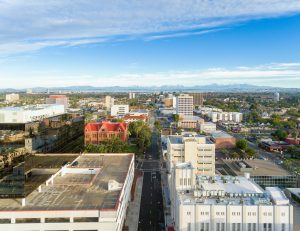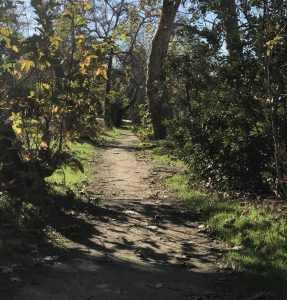|
Ref #
|
Implementation Action
|
Agency/
Time Frame
|
|
GOAL CN-1: Protect air resources, improve regional and local air quality, and minimize the impacts of climate change.
|
1.1  |
Air quality planning. Review existing and monitor the development of new air monitoring and emissions reduction plans prepared by the South Coast Air Quality Management District. Gather and evaluate measures and strategies in such plans for their applicability to and feasibility for Santa Ana.
|
PBA 2022 & annually
|
|
1.2 
|
Community identification. Coordinate with the South Coast Air Quality Management District and local stakeholders to pursue a priority community designation for eligible environmental justice areas of the city , with focus on areas with unique needs and highest pollution burden as identified in the CalEnviroScreen tool. If such designation is not awarded, seek grant funds for activities such as local air quality monitoring.
|
PBA 2022 & Ongoing
|
|
1.3 
|
Proactive engagement. Collaborate with the South Coast Air Quality Management District and local stakeholders in environmental justice areas experiencing local air pollutions issues to outline objectives and strategies for monitoring air pollution in advance of the establishment of a community emissions reduction and/or air monitoring plan.
|
PBA 2022 & Ongoing
|
|
1.4 
|
Health risk criteria. Establish criteria for requiring health risk assessments for existing and new industries, including the type of business, thresholds, and scope of assessment. Review existing and establish new regulation to reduce and avoid increased pollution near sensitive receptors within environmental justice area boundaries.
|
PBA 2022-2027
|
1.5  |
Agency permits. Monitor the South Coast Air Quality Management District permitting and inspection process and the Orange County Health Care Agency to identify businesses in Santa Ana with potential hazardous materials or by-products, with a special focus on environmental justice communities. Serve as a liaison for residents to identify potential emission violations. Share information and data with the community on the City’s Environmental Quality web page.
|
PBA 2022 & Ongoing
|
|
1.6 
|
Emissions monitoring. Coordinate with the South Coast Air Quality Management District to monitor existing air measurements and recommend new air measurements and locations.
|
PBA 2022 & Ongoing
|
|
1.7 
|
Truck idling. Evaluate strategies to reduce truck idling found or reported in areas with sensitive receptors, with a priority placed on environmental justice areas.
|
PBA/PD 2022-2024
|
|
1.8 
|
Improve older trucks. Promote the City’s Vehicle Replacement Plan and explore the replacement of older trucks through City participation in regional incentive programs and education of Santa Ana private fleet owners of program opportunities.
|
PWA 2022
|
|
1.9 
|
Indirect source rules. Support the development of indirect source rules, drayage truck rules, advanced clean truck routes, and heavy-duty low NOx rules by the South Coast Air Quality Management District.
|
CMO
Ongoing
|
|
1.10 
|
Interagency team. Establish an environmental quality interagency team to evaluate, monitor, and make recommendations to address air quality and environmental hazard issues, with a special focus on environmental justice areas. Publish results and information on the City’s website through a dedicated Santa Ana Environmental Quality web page.
|
PBA 2022 & Ongoing
|
|
1.11 
|
Public education. Augment existing outreach programs to improve public awareness of State, regional and local agencies’ roles and resources to identify, monitor, and address air quality and other environmental hazards in the community.
|
PBA/PWA
Ongoing
|
|
1.12 
|
Data collection for emissions plans. Coordinate with the South Coast Air Quality Management District to explore ways to initiate data collection efforts for a community emissions reduction and/or community air monitoring plan, including the identification of information needed (new or updated), potential data sources and needed resources, and strategies to engage residents and collect information.
|
PBA 2022
|
1.13  |
Community survey on healthy lifestyles. Plan for and conduct a community survey of residents every two years related to community health, pollution, parks, community engagement, and community services, with focused outreach for environment justice concerns and priority areas (tie into other City efforts like Strategic Plan, park and recreation planning, community benefits, etc.).Report findings of survey through the various media platforms and utilize input to inform periodic evaluation and update of General Plan.
|
CMO Every two Years
|
|
1.14 
|
Expanded interactions. Identify opportunities to expand regular attendance and support neighborhood associations and community groups to hold regular meetings with City staff and decision-makers in neighborhoods within environmental justice communities, so that residents, community organizations and businesses can communicate their unique issues and needs, as well as their recommendations on how best to implement environmental quality, environmental health, and environmental justice policies. Arrange for language interpretation services as needed at these meetings so that all residents can participate.
|
PBA/CMO
Ongoing
|
|
1.15 
|
Expanded representation. Expand representation of residents from neighborhoods within environmental justice area boundaries by extending residents from such areas to become board, commission, and task force members as openings occur.
|
PBA/CMO
Ongoing
|
|
1.16 
|
City budget. Evaluate the City’s budget and financial policies to include direction for prioritizing public services and improvements within environmental justice area boundaries. Augment budget meeting presentations to include a section dedicated to the status of actions and improvements to address the needs of residents within environmental justice area boundaries.
|
CMO
Annually
|
|
1.17
|
Transportation Demand Management. Collaborate with the South Coast Air Quality Management District, Orange County Transportation Authority, and other transportation planning agencies to develop a transportation demand management program for small businesses and new multifamily housing in the city to educate and incentivize employees and residents to consider transit, carpool, and active transportation travel choices.
|
PBA/PWA
2023
|
|
1.18
|
Support transit. Support local and regional land use and transportation plans that increase mass transit usage and reduce vehicle trips.
|
PWA
Ongoing
|
|
1.19
|
Climate Action Plan. Review and update the City’s Climate Action Plan.
|
PWA 2023
|
Notes:
CDA – Community Development Agency; CMO – City Manager’s Office; HR – Human Resources Department; PBA – Planning and Building Agency; PWA – Public Works Agency; PRCSA – Parks, Recreation and Community Services Agency; PD – Police Department
 associated with environmental justice policies associated with environmental justice policies |







